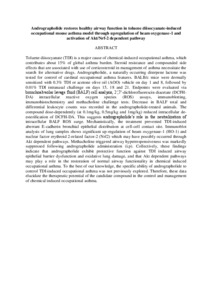Citation
Sulaiman, Ibrahim and Tan, Khaishin and Mohtaruddin, Norhafizah and Lim, Jonathan Chee Woei and Stanslas, Johnson
(2017)
Andrographolide restores healthy airway function in toluene diisocyanate-induced occupational mouse asthma model through upregulation of heam oxygenase-1 and activation of Akt/Nrf-2 dependent pathway.
The FASEB Journal, 31 (supp. 1).
ISSN 0892-6638; ESSN: 1530-6860
Abstract
Toluene diisocyanate (TDI) is a major cause of chemical-induced occupational asthma, which contributes about 15% of global asthma burden. Steroid resistance and compounded side effects that are associated with use of corticosteroid in management of asthma necessitate the search for alternative drugs. Andrographolide, a naturally occurring diterpene lactone was tested for control of cardinal occupational asthma features. BALB/c mice were dermally sensitized with 0.3% TDI or acetone olive oil (AOO) vehicle on day 1 and 8, followed by 0.01% TDI intranasal challenge on days 15, 18 and 21. Endpoints were evaluated via bronchoalveolar lavage fluid (BALF) cell analysis, 2′,7′-dichlorofluorescin diacetate (DCFH-DA) intracellular reactive oxygen species (ROS) assays, immunoblotting, immunohistochemistry and methacholine challenge tests. Decrease in BALF total and differential leukocyte counts was recorded in the andrographolide-treated animals. The compound dose-dependently (at 0.1mg/kg, 0.5mg/kg and 1mg/kg) reduced intracellular de-esterification of DCFH-DA. This suggests andrographolide’s role in the neutralization of intracellular BALF ROS surge. Mechanistically, the treatment prevented TDI-induced aberrant E-cadherin bronchial epithelial distribution at cell-cell contact site. Immunoblot analysis of lung samples shows significant up-regulation of heam oxygenase-1 (HO-1) and nuclear factor erythroid 2-related factor-2 (Nrf2) which may have possibly occurred through Akt dependent pathways. Methacholine triggered airway hyperresponsiveness was markedly suppressed following andrographolide administration (i.p). Collectively, these findings indicate that andrographolide exhibit protective function against TDI induced airway epithelial barrier dysfunction and oxidative lung damage, and that Akt dependent pathways may play a role in the restoration of normal airway functionality in chemical induced occupational asthma. To the best of our knowledge, the specific ability of andrographolide to control TDI-induced occupational asthma was not previously explored. Therefore, these data elucidate the therapeutic potential of the candidate compound in the control and management of chemical induced occupational asthma.
Download File
![[img]](http://psasir.upm.edu.my/60865/1.hassmallThumbnailVersion/Andrographolide%20restores%20healthy%20airway%20function%20in%20toluene%20diisocyanate-induced%20occupational%20mouse%20asthma%20model%20through%20upregulation%20of%20heam%20oxygenase-1%20and%20activation%20of%20AktNrf-2%20dependent%20pathway.pdf)  Preview |
|
Text (Abstract)
Andrographolide restores healthy airway function in toluene diisocyanate-induced occupational mouse asthma model through upregulation of heam oxygenase-1 and activation of AktNrf-2 dependent pathway.pdf
Download (107kB)
| Preview
|
|
Additional Metadata
Actions (login required)
 |
View Item |

